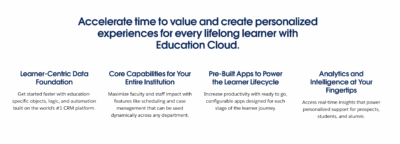Blog
20/04/2023
What does the new Salesforce Education Cloud mean for education institutions?
To those of you who have followed the news in the Education space around Salesforce, this might not be news, but Salesforce is rolling out a new Education Cloud. When the rollout is done (probably after the next two major releases), it will cover the functionality of the previous EDA product and more.
As with any new product innovation, there is a lot of excitement around the reveal and a bit of worry as well. What does the new product mean for institutions already using Salesforce? How can we benefit, and when? Good questions that you should be asking.
As Simon Sinek has famously said, always start with Why. So Why the new product? Let’s dig into the topic.
Uncertain times in Education and across sectors
We are navigating through uncertain times across sectors. In education, there is a need to improve enrolment and graduation rates, staff recruitment and retention, and deliver on higher expectations. Funding continues to be a challenge, especially with the rising costs. There is a call for innovative approaches in the core business that requires, in turn, innovative technologies. And that is the promise at the core of the new Education Cloud.

Salesforce is committed to helping institutions solve these challenges and power the next generation of experiences for lifelong learners. And to achieve this goal, they have announced the reimagined Education Cloud. It’s built closer to the core platform, enabling institutions to take advantage of new product innovations previously available to sectors such as health care and financial services. There are new powerful products coming available to the education sector more quickly, such as EinsteinGPT generative AI as well as Data Cloud and Genie for a unified customer-360 profile with real-time data.
The Education Cloud releases will happen in increments. In the Spring´23 release, Salesforce has made Education Cloud for Recruitment and Admission generally available. So, what’s new with the product and what value does it bring me, you ask? There are at least five key benefits for your institution that you should consider.
New data foundation to drive better outcomes
The new Education Cloud from Salesforce provides a new data foundation to drive better outcomes. The old managed package EDA is out, and now the new data model is built around Person Accounts. This is, in my opinion, a great advantage, because the person accounts data model much better serves institutions in modelling data around both students and partners, giving options for a wider range of capabilities to be covered by the platform. This is also what allows cross-industry innovation on the platform because capabilities built on one industry will use the same foundational information architecture.
The new data foundation in the Education Cloud enables institutions to leverage data-driven insights to improve enrolment and graduation rates, as well as provide personalised experiences that better meet the needs of students, faculty, and staff. This can help drive improved student retention, increased revenue, and enhanced institutional reputation.
The industry-specific data architecture has for years been at the core of the industry solution, enabling institutions to leverage the peer-reviewed model (it has been and continues to be heavily influenced by advisors from the industry).
Scale common services institution-wide
A new capability model in Education Cloud allows common services available in Education Cloud to be scaled institution-wide. These include things such as appointment scheduling and application forms. This can help institutions reduce costs by providing efficiencies through automation, standardisation, and consistent workflows, which in turn can improve the overall student experience and satisfaction, leading to increased enrolment and retention rates.
One of the key advantages of Salesforce across industries has always been its ability to scale across key business functions while retaining modularity that gives flexibility to the IT strategy of the organisation. The CRM at the core offers an impressive foundation to build a whole digital service platform on, or just pick and select capabilities where your institution has a gap that could be filled with Salesforce. The modular structure of the product is a strength because it gives you options without forcing you to go “all-in”. Make the choice based on your context and your strategy. Often it makes sense to have an outside view, which is where an experienced Salesforce SI can bring a lot of value.
Take advantage of innovative new capabilities
The new Education Cloud offers access to new innovative capabilities built in collaboration with other industries, such as Healthcare and Public Sector, including virtual appointments, case management, and care plans. Access to innovative capabilities through the Education Cloud provides institutions with a competitive advantage by enabling them to offer cutting-edge solutions to students, faculty, and staff. This can help lead to increased student satisfaction, retention rates, and institutional reputation.
Salesforce has always been a great platform for innovating. Its robust development tools and declarative solutions offer fantastic opportunities to quickly go from idea to wireframe to prototype, proof-of-concept, whatever new solution idea you have before implementing those that stick. For me, one of the tools I’ve been most looking forward to is OmniStudio, which I’m confident will have a significant role in the new Education Cloud. It’s a declarative automation tool that offers incredible flexibility not available previously with the tools on the platform.
Create meaningful connections and experiences
Smart prospecting in the Education Cloud enables institutions to create meaningful connections with prospective students, which can result in higher conversion rates and improved enrolment. By using personalised engagement strategies, institutions can build a sense of belonging with prospective students, which can result in improved student satisfaction and retention rates.
Smart prospecting allows you to segment your prospects, assign them to recruiters, and enable personalised prospect engagement at scale from the very first interaction. The transformed applicant experience makes it easy for students to apply to multiple programs, track application statuses, and interact with admissions teams. And the expanded appointment scheduling can be used as a cross-campus service for virtual meetings with recruiters and admissions interviews.

Salesforce has always had a great marketing automation suite, but from the point-of-view of a university, it’s more of a tool for recruitment and communications. As a rule of thumb, the best use is at those stages of your R&A pipeline where there is a high amount of communication that needs to be personalised and managed efficiently, such as onboarding, or high-value communication that needs to be personalised, such as post-graduate recruitment. Content creation for the emails being sent out is also looking to become much easier, with generative AI capabilities being added to the platform to assist in the work being done by the content creators. Write me an engaging welcome admission email template with a personalised title, name and program details for each of the schools. Yes, please.
Streamline admissions workflows
Streamlined admissions workflows in the Education Cloud can help institutions reduce administrative burdens and improve staff efficiency. This results in staff having more time to focus on student support and engagement, which can lead to improved student retention rates, institutional reputation, and revenue. And let’s be honest, who wouldn’t like to have more time to do the engaging work and less time spent on repetitive tedium?
And the good news is Education Cloud for Recruitment and Admissions is now generally available as part of the Salesforce Spring ’23 Release. This includes smart prospecting for recruiters, a transformed applicant experience, expanded appointment scheduling, streamlined admissions workflow, and care plans for students.
The road ahead
There are obviously many reasons to be very thrilled about the new developments for Education Cloud. Some of the things we don’t yet know, such as how many of the new products old customers will be able to take advantage of without migrating to the new product, and there are also no migration paths or support available yet. Salesforce has said that migration support will be made available (probably at the next Winter release, although don’t hold me to that).
New customers to Salesforce will automatically receive the new Education Cloud. Those institutions that already have EDA installed can be certain that the core capabilities such as EDA, Student Success Hub and Admission Connect will remain relevant and supported. Regardless, if you haven’t already, it is a good time to start looking into the news around the new Education Cloud and planning how your institutions could take advantage of new capabilities. As I write this, there is a free 30-day trial available on the Salesforce website for the new Education Cloud to those that want to try it out.
If you want to talk to an implementation partner with experience in the sector and with Education Cloud to explore the possibilities and options you have, reach out for a chat!

Kari Poutanen
Director, Education
kari.poutanen@fluidogroup.com
Read next
04/05/2023
The German tour kicks off: Fluido at the Salesforce World Tour Essentials in Munich
2 minute read
